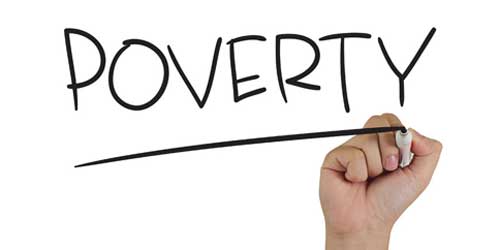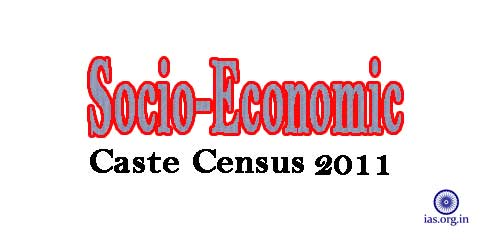India’s Five Year Plan at a Glance
Poverty Types and Indicators
Absolute Poverty
Relative Poverty
Multidimensional Poverty Index
- Years of Schooling – Deprived if no household member has completed five years of schooling.
- Child Enrollment – Deprived if any school-aged child is not attending school in years 1 to 8.
Don’t Miss: Poverty Alleviation Programs in India
- Child Mortality – Deprived if any child has died in the family
- Nutrition – Deprived if any adult or child for whom there is nutritional information is malnourished.
- Electricity – Deprived if the household has no electricity.
- Sanitation – Deprived if they do not have an improved toilet or if their toiled is shared (MDG Definition).
- Drinking Water – Deprived if the household does not have access to clean drinking water or clean water is more than 30 minutes walk from home (MDG Definition).
- Floor – Deprived if the household has dirt, sand or dung floor.
- Cooking Fuel – Deprived if they cook with wood, charcoal or dung.
- Assets – Deprived if the household does not own more than one of radio, TV, telephone, bike or motorbike.
Journal and Ledger Account
Example of Journal and Ledger Account Preparation:Learning Objectives:
Journalise the following transactions and post them to the journal and ledger accounts concerned:
Solution:
LEDGER ACCOUNTPurchases Account
Cash Account
Karim Account
Sales Account
Machinery Account
Rahim & Sons Account
Discount Account
Rent Account
Salaries Account
|
Evolution of Postal Services
Rapid evolution in postal services has made it possible to send messages more quickly and easily today. Let’s have a look at its journey from past to present in context Indian Post.
Postal services in the past
In this modern age, that is today, the postman delivers letters to every home. However, in the past, the privilege of sending the message to anyone (post) was enjoyed only by kings and emperors. They used runners, trained particularly for the purpose of delivering post, to carry messages to other rules and their commanders during times of war. Generally, a king or an emperor would have a message inscribed on a clay tile and send a runner to take it to another king or emperor.
However, there are ample historical evidence that suggests that the ancient Egyptians had developed a kind of postal system and so had the ancient Chinese. The early postal systems relied upon post houses which served the carriers of the message. It was Romans who, in the ancient world, created most highly developed and dependable system that could deliver messages cover 270 kilometers in 24 hours.
Read Also: From e-Post to eIPO (Indian Postal Order)
Pigeons as carriers of messages
Today, when we wish to send our friend a message, we just send a letter. However, it is very interesting, even to imagine, that about 3000 years ago the Queen of Sheba and King Solomon used to exchange messages by using carrier pigeons. Those pigeons were specially trained particularly in finding their way back home when they were released. The Persians and the Egyptians first used carrier pigeons some 3000 years ago.
These carrier pigeons fulfilled many purposes during the war, flying through the sky with airplanes, being fitted with cameras to take the pictures of enemy positions. However, the most important role of pigeons were to serve as messengers.
The most famous of all the carrier pigeons probably was one named Cher Ami (two French words meaning ‘Dear Friend’) who flew 12 important missions to deliver messages. It is speculated that perhaps the most important message Cher Ami carried was the one that saved the lives of over 200 American soldiers, even though he was badly wounded by enemy fire.
The Post riders
Many a times we often give a letter to someone who is going abroad so that he can pass it on to our relative or friend who lives there. This is the same method that was used in earlier times when there were no postal services. This method of using travelers in delivering messages to other places grew, with the time, into a system called Postriders.
So after going through the evidence, we can say that post riders were a horse and rider postal delivery system that existed at various times in many places throughout the course of history. Postriders collected and delivered mail in the course of their route, meeting at scheduled places and scheduled times. At these scheduled places, letters and parcels were exchanged and forwarded to the next destination by the riders. In this way, messages could be passed to a considerable distance.
Read Also: The Universal Postal Union (UPU)
The Pony Express
It was a fast mail service that used to cross the North American continent from the Missouri River to the Pacific coast. Messages were carried on horse back to be rallied across the plains, deserts and mountains of the Western United States. Compared to its earlier postal services or delivery services the Pony Express was very fast.
However, when telegraph wires, in 1861, linked New York to San Francisco, the Pony Expressed went out of business. But the tales of their courage and determination in delivering messages through rain and snow, sleet and ice, over the toughest mountain trails and roughest desert have become legendary.
Mechanization of Postal Services
It was between World War I and II many postal systems introduced in their postal services the conveyor belts to move mail between handling points. One of the most highly mechanized in the context of postal services was the lette- sorting office at Mount Pleasant in London.
Slowly and systematically, machines were introduced in preparing mail, and sorting small letters from the bigger ones. The machines to stamp the date on letters and put them into sacks were also came into existence.
In the modern, mechanized sorting system, that postal services enjoy, the workers (rather operators) sit at a key board while letters are mechanically passed before them. An estimated 50 to 60 letters per minute are processed by the operator. The letters are separated, based on the code entered by the operator into the machine, into different bins, and then removed, bundled and dispatched by the postal workers.
Problems of early postal services systems
As postal services grew, and the mail they handled increased volume-wise, many problems emerged. At the very beginning, the cost of transport was high, and it was near impossible to calculate the exact cost of sending letters to other countries.
Delivery was often quite slow and, therefore, resulted in people getting the services of other means to send their messages. Due to this, many illegal postal services sprung up, causing heavy losses to official postal services.
Slowly but steadily, these problems were controlled and overcome. Uncertainties in the context of the problem who would pay the cost and regularize charges in availing postal services were done away with the introduction of the postage stamp by Henry Bishop. Another achievement for the system of postal services was that now unnecessary delays could be checked because the day and month were also printed on the stamps.
Today we have speed post (whet to say of ‘airmail’) that guarantees delivery in 24 hours to most places. We have journey a long way indeed from the days when it sometimes took weeks or even months for an urgent letter to reach the destination.
Socio Economic Caste Census (SECC) – 2011
The Socio Economic Caste Census (SECC) 2011, a study of socio-economic status of rural and urban households that permits ranking based on predefined parameters, was initiated in June 2011 by the Ministry of Rural Development of Government of India. In Socio Economic Caste Census, 2011, for the first time a comprehensive exercise of door to door enumeration across the country has been carried out for both rural and urban India. This census, Socio Economic Caste Census -2011, is also expected to generate information on a large number of social and economic indicators linked to households across the country.
Socio Economic Caste Census -2011, has three constituents that were conducted by three separate authorities but under the overall coordination Department of Rural Development. The Department of Rural Development (DoRD) has conducted Census in Rural Areas. Census in Urban Areas falls under the administrative jurisdiction of the Ministry of Housing and Urban Poverty Alleviation (MoHUPA). Administration of the Caste Census is controlled by Ministry of Home Affairs: Registrar General of India (RGI) and Census Commissioner of India.
Socio Economic Caste Census 2011 is a unique paperless Census in which the counting of the data was done by using over 6.4 lakh electronic handheld instruments. Apart from School Teachers and Data Entry Operators as enumerators, Gram Panchayats and Gram Sabhas were involved in this process.
Read Must: CAG Tables Report On Implementation Of MGNREGA
Objectives of SECC-2011
The objectives of the Socio Economic Caste Census 2011 are to empower households to be ranked based on their socio-economic status- by using this data State Governments can prepare a list of families that are living below the poverty line; to cater authentic information that would enable caste wise population counting of the country; and to provide authentic information about the socio-economic condition, and education status of numerous caste and sections of the population.
The MoRD has decided to use the Socio Economic Caste Census data in all of its programmes as these data would have appropriate use in projects such as Housing for All, Education and Skill Trust, MGNREGA, National Ford Security Act, interventions for differently able, etc.
Outcomes of the Socio-Economic Data for Rural India
On July 3, 2015, the provisional socio-economic data for Rural India was released, after the survey had been completed in all the640 districts. It was released because its use in evidence based planning for rural development and poverty decimation needed to be undertaken immediately.
Survey done in rural areas has reflected some disturbing outcomes that manifest the current status of India’s rural section. It indicates that most of the rural population is engaged in unorganized sectors’ jobs. The survey discloses that 49% of the rural population have signs of poverty; around 2,37 crore houses have either Kuchha Wall or roof or one room or less; Less that five percent of rural households pay income tax. Even in rich states like Kerala, Tamil Nadu and Maharashtra this number hangs around the five per cent mark; just twenty percent of the rural households possess a vehicle and only eleven percent have refrigerator, however it is encouraging to know that about 72 per cent possess a phone of some sort; and about 30% of rural households do not have any land and they get a major part of their income from manual labour.
According to SECC-2011, 23.5% of rural households does not have a literate adult above the age of 25. Of the illiterate rural population, about 20% have not even completed their primary education.
In urban areas a large percentage of population suffer the lack of basis amenities of water and electricity. According to Socio Economic Caste Census about 20 Lakh households have no electricity supply and50 Lakh households do not have the access of drinking water within their premises.
It is disappointing that the socio-economic indicators of various caste groups have not been released.
Read Also: The Parliament : Lok Sabha and Rajya Sabha
The Criteria Exclusion in Socio Economic Caste Census
SECC has catered for automatic exclusion on the basis of 14 grounds; automatic exclusion on the basis of 5 grounds and grading of deprivation on the basis of seven criteria. The phrase exclusion in socio-economic census indicates those persons who are not going to be considered entitled for major anti-poverty efforts.
Drawback of the Exclusion Criteria
It has been found that if the proposed exclusion criteria is applied, a little under 40% of the rural households would become ineligible for entitlements provided by the Union Government.
Sensing and accepting that a large number of poor people are left, the expert committee on the use of SECC data for rural development recommended to relax the exclusion criteria so that a household would be excluded either if it had any one of the five specified indicators or if it possessed any two of their remaining exclusion indicators.
Read Also: Governor : The State Executive Head






